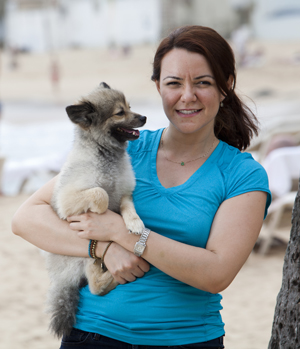Meylinn's Story
Here’s the scenario: You know something’s wrong, but you don’t know what. Since your teenage years, you’ve had sharp, off-and-on pains in your lower back that doctors blame on a slight curvature of the spine (scoliosis). But no treatments seem to help and the pain progresses. By the time you’re in your late 20s, you can’t stand for more than 5 to 10 minutes at a time, and have trouble performing even the most basic activities, including self-care.

After microsurgery to remove a rare spinal tumor, Meylinn and her pup can now visit the beautiful beaches in Puerto Rico.
That was how Meylinn Martinez felt before an MRI of her back revealed the real root of her problem: an unusual growth on her lower spinal cord. Her primary physician immediately referred her to Zachary Levine, MD, medical director of neurosurgery for Holy Cross Hospital, who refined the diagnosis even further.
An Extremely Rare Cyst
“Through neuro-imaging techniques and a biopsy, we discovered Meylinn, then 29, had an extremely rare cyst,” he explains. “It was a type of tumor that arises before birth, but she probably wasn’t aware of it until it started growing and giving her problems.”
While they are not cancerous, and thus not dangerous in and of themselves, cysts like Meylinn’s can wreak havoc if they lodge in the wrong spot. Meylinn’s was pressing upon vital nerves, causing unrelenting pain in her back and waist. She needed surgery as soon as possible.
A Difficult and Delicate Surgery
The location of Meylinn’s cyst, however, made surgery precarious. One misstep in the operating room could have affected her bowels, bladder or legs, leaving her incontinent or even paralyzed from the waist down.
Fortunately, Dr. Levine is experienced with the most difficult neurosurgeries and had the expertise, state-of-the-art technology and other resources to tackle Meylinn’s tumor.
“This type of cyst is so unusual that, in my entire career, I had only operated on two patients with the same condition before Meylinn,” he says. “And their cysts were in the brain, not spine, so it’s a different surgery.”
The delicate procedure required microsurgery, a highly advanced laser scalpel and constant monitoring of her spinal cord to protect critical nerves from damage. The latter helped guide Dr. Levine’s approach and preserved her ability to feel and function.
During the three-hour procedure, Dr. Levine first removed bone from the spinal column so he could reach the spinal cord. Next, he opened up the protective sheath covering the spinal cord and then used a specialized piece of equipment to carve the cyst off.
Only five days later, Meylinn went home.
No Comparison
Today, Meylinn is walking on her own, and once again able to take care of herself. While she still receives physical therapy, she credits Dr. Levine and Holy Cross Hospital for “allowing me to have a better quality of life.”
“After my experience, I can attest that Holy Cross Hospital can take care of the most high-risk surgeries like mine,” she says. “My cyst was in a very critical position, and Dr. Levine and his staff were able to remove it safely. He’s an extraordinary neurosurgeon."
